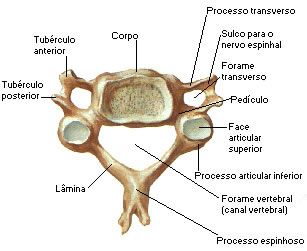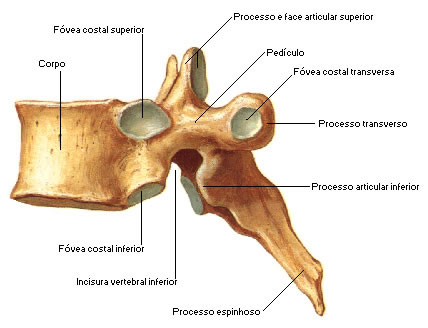Regional Features
They allow the differentiation of the vertebrae belonging to each region.
There are several differentiating elements, but it will suffice to observe the transverse processes:
Cervical Vertebrae:
They have a small body except for the first vertebra. In general, they present a bifid and horizontal spinal process and their transverse processes have transverse foramina (passage of vertebral arteries and veins.
| CERVICAL VERTEBRA |
 |
| Source: NETTER, Frank H.. Atlas of Human Anatomy. 2nd edition Porto Alegre: Artmed, 2000. |
Thoracic Vertebrae:
The spinous process is not bifurcated and is descending and pointed. The thoracic vertebrae articulate with the ribs, and the articular surfaces of these vertebrae are called fovea and hemifovea. The fovea can be located in the vertebral body, pedicle, or in the transverse processes.
| THORACIC VERTEBRA |
 |
| Source: NETTER, Frank H.. Atlas of Human Anatomy. 2nd edition Porto Alegre: Artmed, 2000. |
| THORACIC VERTEBRA |
 |
| Source: NETTER, Frank H.. Atlas of Human Anatomy. 2nd edition Porto Alegre: Artmed, 2000. |
Lumbar Vertebrae:
Vertebral bodies are larger. The spinal process is not bifurcated and is arranged in a horizontal position. It has a triangular-shaped vertebral foramen and mammillary processes. It has a well-developed transverse process called the costiform appendix. It can also be distinguished by not having a foramen in the transverse process or a costal fovea.
| LUMBAR VERTEBRA |
 |
| Source: NETTER, Frank H.. Atlas of Human Anatomy. 2nd edition Porto Alegre: Artmed, 2000. |
| General features | Individual Characteristics |
